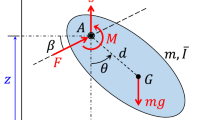Abstract
In the present study, inertial forces and kinematics of wings of locusts, Schistocerca americana, were investigated experimentally. The developed experimental setup includes freshly extracted hindwings and forewings, a mechanical transmission producing pitching and flapping, a vacuum chamber, and a high-speed video system. Flapping angle amplitudes determined at the middle section are practically the same in air and in vacuum in both forewings and hindwings. Pitching amplitudes in the root and in the middle section of hindwing differ by up to 50 % due to torsional deformation or twist. In air, the average twist angles are 3° and 17° in forewings and hindwings, respectively. Amplitudes of twist angle are higher in vacuum, especially at relatively high flapping frequencies. Inertial forces are calculated based on a rigid-body model of a wing with prescribed displacements. The 5-segment mesh for hindwings and 2-segment mesh for forewings provide accurate determination of inertial forces. Amplitudes of the fifth harmonic in accelerations in air are substantially smaller than in vacuum and, therefore, inertial forces in air are about 30 % smaller than those in vacuum. Thus, aerodynamic loads suppressed high-frequency component in wing oscillations resulting in substantially smaller inertial forces in air.




















Similar content being viewed by others
Abbreviations
- A ik , B ik :
-
Coefficients in Fourier series approximations
- c :
-
Wing chord
- F x , F z :
-
Components of aerodynamic force
- f :
-
Flapping frequency
- f c :
-
Cutoff frequency
- K :
-
Number of terms retained in Fourier series approximation
- i, j, k :
-
Indices
- l :
-
Wing length
- m :
-
Wing mass
- N :
-
Number of segments in rigid-body model of wing
- T :
-
Time period of one flapping cycle
- t :
-
Time
- R x , R z :
-
Components of instantaneous reaction force
- Q x , Q z :
-
Components of instantaneous inertia force
- Δw :
-
Out-of-plane deformations in forewings
- xyz :
-
Ground-fixed coordinate system
- x ϕ y ϕ z ϕ :
-
Wing-fixed coordinate system
- \( {\overline{x}}_{CM},{\overline{y}}_{CM} \) :
-
Nondimensional coordinates of wing center of mass
- β :
-
Pitching angle
- Δβ :
-
Peak-to-peak pitching amplitude
- ϕ :
-
Flapping angle
- Δϕ :
-
Peak-to-peak flapping amplitude
- η :
-
Point on leading edge of wing
- Δω :
-
Twist angle
References
Wootton RJ (1981) Palaeozoic insects. Annu Rev Entomol 26:319–344
Ellington CP (1991) Aerodynamics and the origin of insect flight. Adv Insect Physiol 23:171–210
Dudley R (2000) The biomechanics of insect flight: form, function, evolution. University Press, Princeton
Weis-Fogh T, Jensen M (1956) Biology and physics of locust flight. I. Basic principles in insect flight – a critical review. Philos Trans R Soc Lond B 239:415–458
Weis-Fogh T (1956) Biology and physics of locust flight. II. Flight performance of the desert locust (schistocerca gregaria). Philos Trans R Soc Lond B 239(667):459–510
Jensen M (1956) Biology and physics of locust flight, III. The aerodynamics of locust flight. Philos Trans R Soc Lond B 239(667):511–552
Cloupeau M, Devillers JF, Devezeaux D (1979) Direct measurements of instantaneous lift in desert locust; comparison with Jensen’s experiments on detached wings. J Exp Biol 80:1–15
Wilkin P (1990) The instantaneous force on a desert locust, Schistocerca gregaria (orthoptera: acrididae), flying in a wind tunnel. J Kansas Entomol Soc 63(2):316–328
Walker S, Thomas A, Taylor G (2009) Photogrammetric reconstruction of high-resolution surface topographies and deformable wing kinematics of tethered locusts and free-flying hoverflies. J R Soc Interface 33:351–366
Walker S, Thomas A, Taylor G (2009) Deformable wing kinematics in the desert locust: how and why do camber, twist and topography vary through the stroke? J R Soc Interface 38:735–747
Song J, Luo H, Hedrick TL (2015) Wing-pitching mechanism of hovering ruby-throated hummingbirds. Bioinspiration Biomimetics 10
Combes SA (2002) Wing flexibility and design for animal flight. PhD thesis, University of Washington
Singh B, Chopra I (2008) Insect-based hover-capable flapping wings for micro air vehicles: experiments and analysis. AIAA J 46(9):2115–2124. doi:10.2514/1.28192
Wu P, Stanford B, Bowman W, Schwartz A, Ifju P (2009) Digital image correlation techniques for full-field displacement measurements of micro air vehicle flapping wings. Exp Tech 53–58
Wu P, Ifju P, Stanford B (2009) Flapping wing structural deformation and thrust correlation study with flexible membrane wings. AIAA J 53–58
Shkarayev S, Kumar R (2014) Kinematics and inertial effects in locust flapping wings. AIAA 2014–2833, 32nd AIAA Applied Aerodynamics Conference, Atlanta. doi:10.2514/6.2014-2833
Shkarayev S, Kumar R (2014) Instantaneous forces in locust flapping wings. AIAA 2014–2834, 32nd AIAA Applied Aerodynamics Conference, Atlanta. doi:10.2514/6.2014-2834
Hedrick TL (2008) Software techniques for two- and three-dimensional kinematic measurements of biological and biomimetic systems. Bioinspiration Biomimetics 3
Kumar R, Silin D, Shkarayev S (2011) Experimental study of aerodynamic performance of locust and model wings. AIAA-2011-0871, 49th AIAA Aerospace Sciences Meeting and Exhibit, 04–07 January 2011, Orlando, FL
Acknowledgments
This project was sponsored by a grant from the Air Force Office of Scientific Research, FA9550-10-1-0452 (Dr. D. Smith, Program Manager). We would also like to thank Frank Oliver and Michael Fishburn for their contributions to the construction of the vacuum chamber facility. The authors would also like to thank Erlong Su for his assistance with video tracking.
Author information
Authors and Affiliations
Corresponding author
Rights and permissions
About this article
Cite this article
Shkarayev, S., Kumar, R. Kinematics and Inertial Effects in Locust Flapping Wings. Exp Mech 56, 245–258 (2016). https://doi.org/10.1007/s11340-015-0093-2
Received:
Accepted:
Published:
Issue Date:
DOI: https://doi.org/10.1007/s11340-015-0093-2



